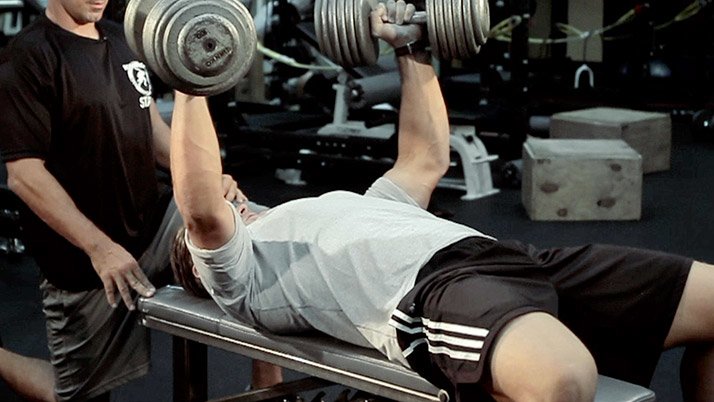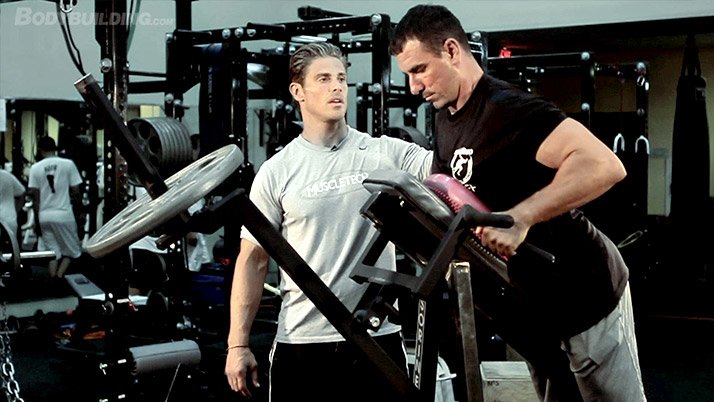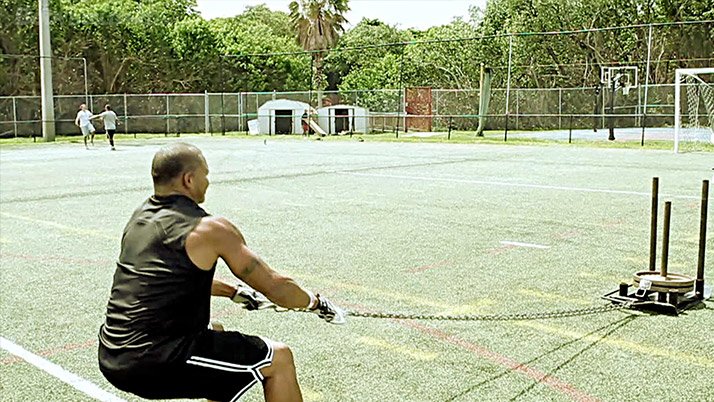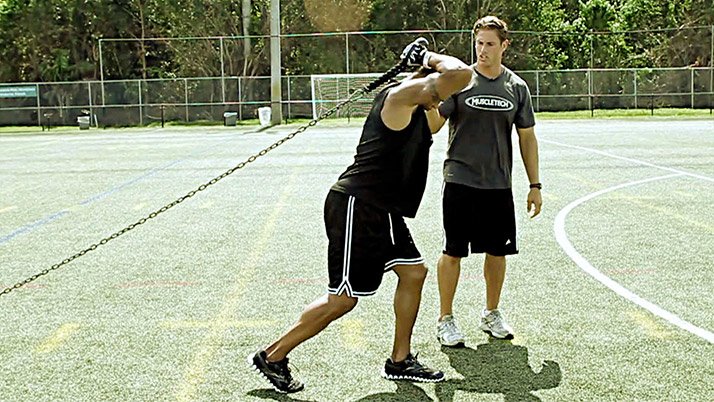
NFL Combine Trainer: 225 Bench Press For Enduring Strength
The 225 bench test provides NFL scouts with a look in an athlete's training past. Let's roll under the bar. It's time to put up or shut up.
Previous Drill | Overview | Next Drill
The 225 bench test in NFL Combine can be evaluated as raw strength endurance. 225 pounds is a weight that is safe and easy to gauge from year-to-year in terms of overall strength endurance, an imperative factor for winning football.
The NFL knows by position how big you are and what your number should be as long as you consistently lift weights. NFL scouts look for a guy who's not afraid to lift and take care of his body. No, you don't have to be a weight room freak. However, you should look at the average numbers, gauge where you currently stand, and then get to where you have to be.
NFL Combine Trainer 225 Bench
Watch the video: 13:13
225 bench totals for different-sized athletes to meet NFL status quo:
- Linemen: 30-39
- Tight Ends and Linebackers: 25-30
- Running Backs: 20-25
- Defensive Backs and Receivers: 15-20
As long as you reach that baseline number, you're looked at as a guy who is not going to be a consistent problem and will follow a proper strength and conditioning program.
Training Terms To Remember
- Concentric: The positive portion of an exercise.
- Isometric: Holding at the top or bottom of a movement.
- Eccentric: The negative portion of an exercise.
6 Exercises For A Greater Bench
Variable Load Speed Bench (12 sets of 3 reps)

The 225 test is a rapid action with a stretch reflex. You want to enhance the motion over time. It's crucial to have speed, but it's equally important have reversal strength and the deceleration component toward the chest.
Use chains that leave a couple links on the ground when your arms are fully extended, to balance and stabilize the bar. If all the chain-links are off the ground, it's tougher balance at the top.
Remember, these are football players, not powerlifters. Become comfortable with the 5-point system to get maximum explosion and strength out of every rep.
The 5-Point System
- Good arch in the back, glutes tight on the bench, feet tight on the floor, shoulder blades squeezed together and head down.
- Use the same setup and grip for each tempo.
- Chains/bands help vary the load (the bar will be lighter at the bottom and heavier at the top). This provides an acceleration component through the end range of motion.
Perform three sets of each tempo for three reps and take a 1- minute rest period between working sets. The Variable Load Speed Bench should be done once per week for two weeks, take a full week off, go back on once per week for 2-to-3 weeks and repeat.
Variable Tempos
(The star designates exploding through the range of motion
- Tempo 1 1-1-*
1 second down - 1 second isometric pause - Explode up through the end range of motion - Tempo 2 *-1-*
High speed eccentric load downward - 1 second isometric pause - Explode up through the end range of motion - Tempo 3 *-*-*
Reflex down and up at the same time with no isometric pause or bounce of the chest. Right before the bar hits the chest it's a rapid deceleration, then a re-acceleration to reversal strength up into the concentric action.It's going to be a bit more challenging in terms of the pressing. Take on the mentality that you're pressing out and away toward your feet.
- Tempo 3 *-*-* (No Pause)
It's the exact same tempo; the only difference is there's no pause at the top. Eliminate the isometric down low, accelerate all the way through the end range of motion and reaccelerate back down into the next rep.
Dumbbell Bench Hammer Grip (3 sets to failure)

You want to position the dumbbells a little wider than the chest and get a good stretch down and as deep as possible. Shoot for endurance and speed. Achieve this by performing the Dumbbell Bench Hammer Grip 1-2 times per week.
The hammer grip works because it alters the rotation of the upper arm and changes the stimulus compared to forward benching. Come out a little wider than the chest and use a deep contraction just to put a different stimulus across all of the muscles involved in the press.
Tempo *-*-*
- It's going to be fast down with no pause and fast up
- Grab dumbbells and get into the 5-point system
- Use heavy weights, come all the way down and lock it at the top
- You're looking for deep, fast and as many reps as possible
Row Isometric Wave Series (4 sets of 5 tempos)

We do a number of isometrics for a reason. Isometric strength in all of your scapula retractors and muscles involved in the rowing action are important.
If you're looking for bench press performance, maintain the isometric position for 35-60 seconds. There is no better way to train isometric strength than Isometric Wave Training with a rowing action.
- Place feet flat on the platform, with most of the weight on your toes.
- Reach down, grab the spider grip, pull the shoulders back into position and lock the arms.
The row isometric wave tempo varies with each rep, using a different tempo:
The first rep will be 1-6-1 (1 second up - 6-second pause - 1 second down; end with two full reps - go to the next 1-5-1 tempo and so on).
Tempo *-*-*
- 6 Sec HOLD / 2 Reps
- 5 Sec HOLD / 2 Reps
- 4 Sec HOLD / 2 Reps
- 3 Sec HOLD / 2 Reps
- 2 Sec HOLD / 2 Reps
Speed Band Push-Downs (3 sets to failure)

The contribution of the triceps and elbow extensors into the bench press is tremendous. This weak link is seen in many athletes. You can really overload it, whether you do a maximal, dynamic or endurance bench press. The triceps are often neglected and extremely underrated. Not anymore.
Perform Speed Band Push-Downs 1-2 times per week and rest as long as it takes to regain strength before the next set. If you don't have bands, a standard cable triceps push-down nearly replicates the exercise, just make sure to do it with a normal tempo. You must create variable resistance. As the band stretches, the load of the band increases through the range of motion.
Every upper body day needs some type of elbow extensor work. Use bands to perfect the acceleration component.
- Stand inside the band with your elbows tight, facing forward with a slight lean.
- Perform speed reps; maintain control and force the band down to get a premium contraction.
- When your triceps fail, reverse the grip and do speed reps again.
(Remember, the final few reps of a set are the most important)
Sled Row (3 sets of 40 yards; 120 total yards)

The bench press is a strength endurance exercise that requires fast and powerful movements while maintaining strength. You have to reverse the motion sometimes to grab another gear and avoid strength decreases or plateaus. The Sled Row counters lagging results. Focus on this 1-2 times per week.
A typical T-bar or dumbbell row is going to be slow and controlled. The sled creates a motion that builds muscular power and endurance over a distance. Exceptional power endurance within a 40-yard distance is a consecutive 20-30 reps without stopping.
- Set your feet a little wider than your shoulders.
- Shoulders are back, butt is down, back is flat and head is neutral to avoid all forward lean and exposure of the lower back.
- Start with your thumbs down and drive your elbows back, while rotating simultaneously to work the rhomboids.
Triceps Sled Row (3 sets of 40 yards; 120 total yards)

Initiate a different stimulus across the triceps to have the same type of elbow extensor strength with powerful actions.
Work the entire length of the 40-yard area and drive as many reps as possible. Perform the Triceps Sled Row 1-2 times per week.
- Start with one foot in front and one foot in back.
- Keep your elbows in front with the hands separated a little bit from your ears.
- Lean and snap forward with full extension without stopping.
- Walk, push, lock it out and remember to always keep the elbows facing forward. If you do it right, the sled shouldn't stop.


